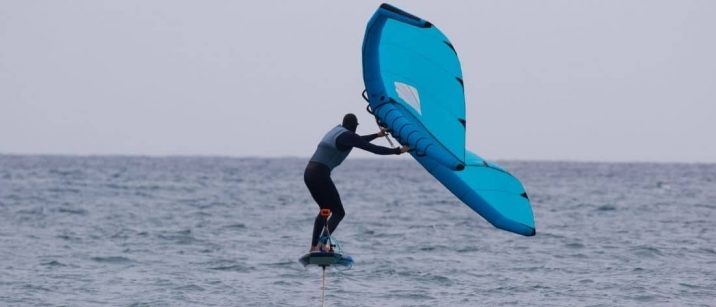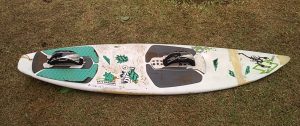Wingfoiling is all the rage in the wind sports world, and makes a great complement to older water sports.
Learning to wingfoil is not that difficult, compared to kiting or windsurfing. Learn the wing control skills separately from the foil skills. Choose the right board, mast, and foil setup, and you can be up and riding within a few days or a few weeks of practice.
Follow the same strategy as you would with most sports: Identify the skills you will need, learn them separately, and then put them together. And, choose the right beginner gear to learn on.
Is learning to use the wing hard?
Learning how to use a wing is easier than with a kite or windsurf sail. You can get a general idea by spending some time standing on the beach with the wing.
On the beach, you can practice holding the wing in different positions, pulling with your back hand to get some power, and releasing to depower.
Get used to keeping the wing in the air and preventing the tips from touching the sand. When the wing dips too low, push down with your back hand to send it higher. This is relatively easy to learn with a bit of practice.
Also, practice flipping the wing over from its back into a sailing position, without letting it touch the sand.
As you get used to riding on the water, you’ll become more precise with controlling the amount of power in your wing, and where that power is pulling from.
You also need to learn how to pump the wing to generate power, and switching sides to change direction, all while keeping it in the air, without touching the water. These skills will take some water time.
Is wing foiling harder in light or strong wind?
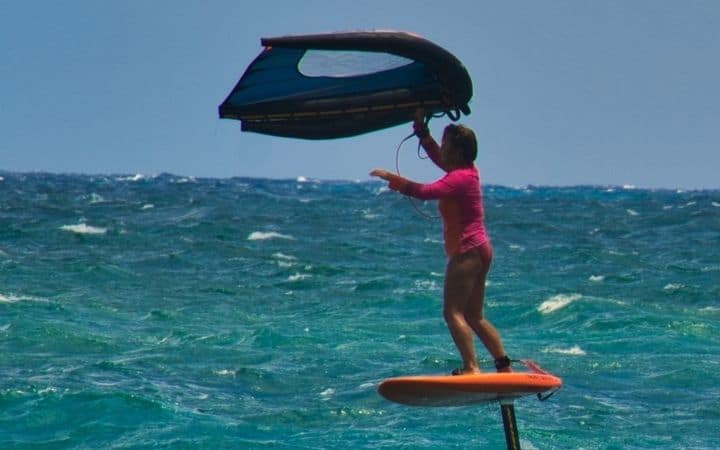
Wingfoiling is much easier in stronger wind, especially if you’re learning. 15 knots is a good minimum to learn in. It’s also easier to learn in flat water, although stronger winds may bring more chop as well.
Wing sizes range from about 3 m2 to over 6 m2. In 15 knots, with a body weight of 80kg you can start with a 4 or 5 square meter wing. With a bigger wing, it may be more difficult to keep the wingtips from touching the water.
Popular wings include the Cabrinha Mantis, the Slingshot Slingwing, or the Airush Freewing Nitro. See the wing selection here on Green Hat.
Is wing foiling easier if you kitesurf/windsurf/surf etc?
If you already have experience with other wind sports, wing foiling will be much easier to learn. Having an intuitive feel for concepts like wind directions, the “across the wind line,” and stall and luff points will help.
Familiarity with a board sport will get you through the first stages more easily as well. If you’re a good snowboarder, for example, you could start getting the basics of riding around on a floating board in as little as two sessions.
Once you’re up on the foil, though, everything changes.
The control of the wing is more like a windsurf sail than a kite. Mast back to go upwind, front arm straight to maximize power, pumping to get bursts of power – your windsurfing experience will help you.
But be careful not to let your habits from windsurfing or kitesurfing work against you. Wingfoiling requires a different set of skills than both of these.
Is wing foiling harder than wing surfing?
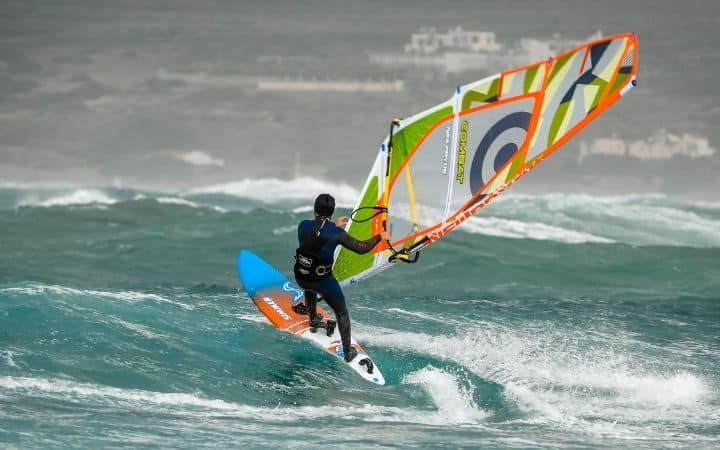
Wing surfing (on a floating board) is much easier than wingfoiling! It doesn’t take much time to get comfortable with riding, staying upwind, and jibing.
You can start with a SUP (stand up paddleboard), or a wind SUP. It’s even easier on a large-volume beginner windsurf board – above 200 liters.
The daggerboard on the wind SUP or beginner board will add stability, and make it easier to track upwind so you can focus on controlling the wing.
Using a foil is a distinct skill altogether. If you’ve never ridden a foil before, it’s best to work on foil skills separately.
You can try being pulled behind a boat or jetski. You can even learn on a self-powered electric foilboard such as an e-foil, or a motorized SUP with a foil. If you already windsurf or kitesurf, then learn to ride a foil on one of those first.
Wing foiling is easier if you have the right gear
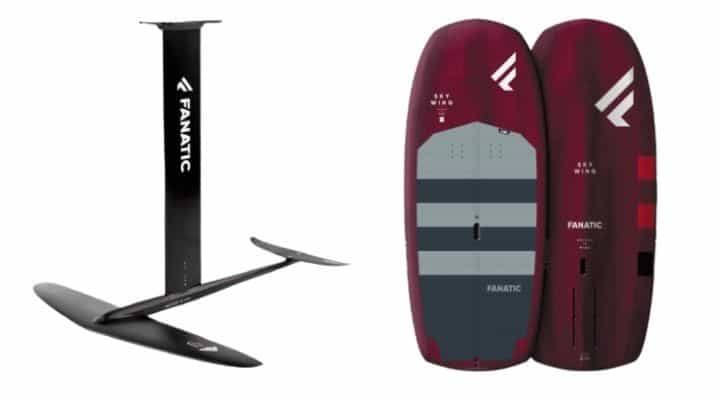
As a beginner, it’s crucial to have the right equipment to learn on – otherwise, learning will be slow and difficult. Besides the wind wing (see above), here are a few important things to keep in mind for gear.
Start with a large board with enough volume to stand on and balance easily– at least 40 more liters of volume than your body weight. The Lahoma foil board is particularly well-regarded for learning to wing foil.
Use a bit longer mast than you use for learning to kitefoil. A 75cm mast will be stable enough to practice on. Later on, you can go to 90cm to avoid bottoming out in bigger chop.
It’s especially important to choose a front foil wing that’s easy to learn on– stable, and with lots of lift. Greater lift will get you riding at lower speeds. Look for these three things:
- Surface area: The bigger the foil, the more lift it generates, and the easier it is to ride. Start with at least 2000 square centimeters — some beginner foils go up to 2400cm.
- Aspect ratio: A lower aspect foil has a rounder shape and is more stable. Higher aspect foils require more speed to get going and are more sensitive – and hence more challenging.
- Profile: A thicker profile hydrofoil generates more lift for the same surface area, making it easier for a learner. Beginner foils may be over an inch thick.
The rear stabilizer wing helps dampen the tendency of the board to point up and down, and from side to side. Start with about a 300 square centimeter stabilizer if you can.
Finally, a longer fuselage — the distance between the front and back wings — gives more stability on pitch control, and less sensitivity to up and down movements, making things it challenging with a wing.
It’s a trade-off: stability against maneuverability and agility. For learning, stability makes things easier. As you get better control of the foil, you will want more speed, turning ability, and capability to pump the foil.
Check out the wing foil prices here on Green Hat
Is waterstart hard on a wingfoil?
The most basic form of waterstart is easy, especially on a high volume board. Just stand, position the wing, and power up to start moving.
Intermediate wingfoilers use progressively smaller boards. With smaller boards, waterstarting means getting moving while on your knees, then moving into a standing position. It requires more balance, and takes longer to learn.
Waterstarting on an advanced “sinker” board – less volume than your body weight, typically 50-70 liters – is the most difficult. You may be in the water up to your waist, with your knees on the board.
With a small board, you need to be good at pumping the foil hard to get going. As you pick up speed, you bring the board up out of the water and use the wing to help you stand.
Recovering the board after a crash won’t be difficult, as you should be wearing a leg leash attached to your board.
Is riding upwind and jibing on a wingfoil hard?
Once you’re able to ride and stay on a foil, it’s not difficult at all to go upwind. You’ll be able to ride upwind right away, though not as close to the wind as you could on a kitefoil or a windsurf foil.
Even though a wing pulls from further downwind than a kite or a windsurf sail, the efficiency of the foil and the size of the mast will help you go upwind with ease.
Changing tacks on a wingfoil smoothly usually takes a few sessions. At first, it will mean dropping the board back onto the water to jibe. If you fall in the water during the jibe attempt, you can easily reposition yourself and your gear to get going in your new direction.
As you get better, you will learn to complete your jibe without touching the board on the water. You can even learn to tack, although that’s more advanced.
Is jumping really hard on a wingfoil?
Jumping on the wingfoil is an advanced skill which takes practice, ability to ride a smaller board, and familiarity with stronger conditions.
Some wingfoilers are happy to ride around without ever learning to jump. After all, the biggest draw for many is the ability to ride waves and swells on the foil. They just use the wing to get upwind, then ride back down with the wing depowered.
To jump, you’ll need straps, and you’ll need to be powered up. You can start by jumping off chop or waves, but you don’t need to. On a wingfoil, you are primarily using the foil to jump.
Jumping on a wingfoil in 4 easy steps
- The approach: accelerate, pull in with your back hand, point upwind slightly, and get the foil lower in the water. Bend your legs, and prepare for the pop.
- The jump: push down with your back leg to send the board up and out of the water. Keep the wing above you like an umbrella, with your back hand pulling in to keep powered. Bend your knees.
- The landing: spot your landing (look at the water where you will re-enter). Point the board in the direction you are moving, which will be a bit downwind. As you come down, extend your legs so you can absorb the impact from landing.
- Recovery: straighten your legs to stand up again. Pull in with your back hand, or pump the wing if necessary to keep your speed up and ride away.
Conclusion
Wing foiling is much easier to learn than windsurfing or kitesurfing, especially for people under 30. It may take anywhere from a few days to several weeks to learn to wingfoil. This will depend on your background experience, the conditions you’re learning in, and the equipment you are using.
***
Image credits:
(2) “Wing Surfers” (CC BY-SA 2.0) by Kirt Edblom


